Duncan Smith: Meeting our net zero and fuel poverty targets affordably and sustainably
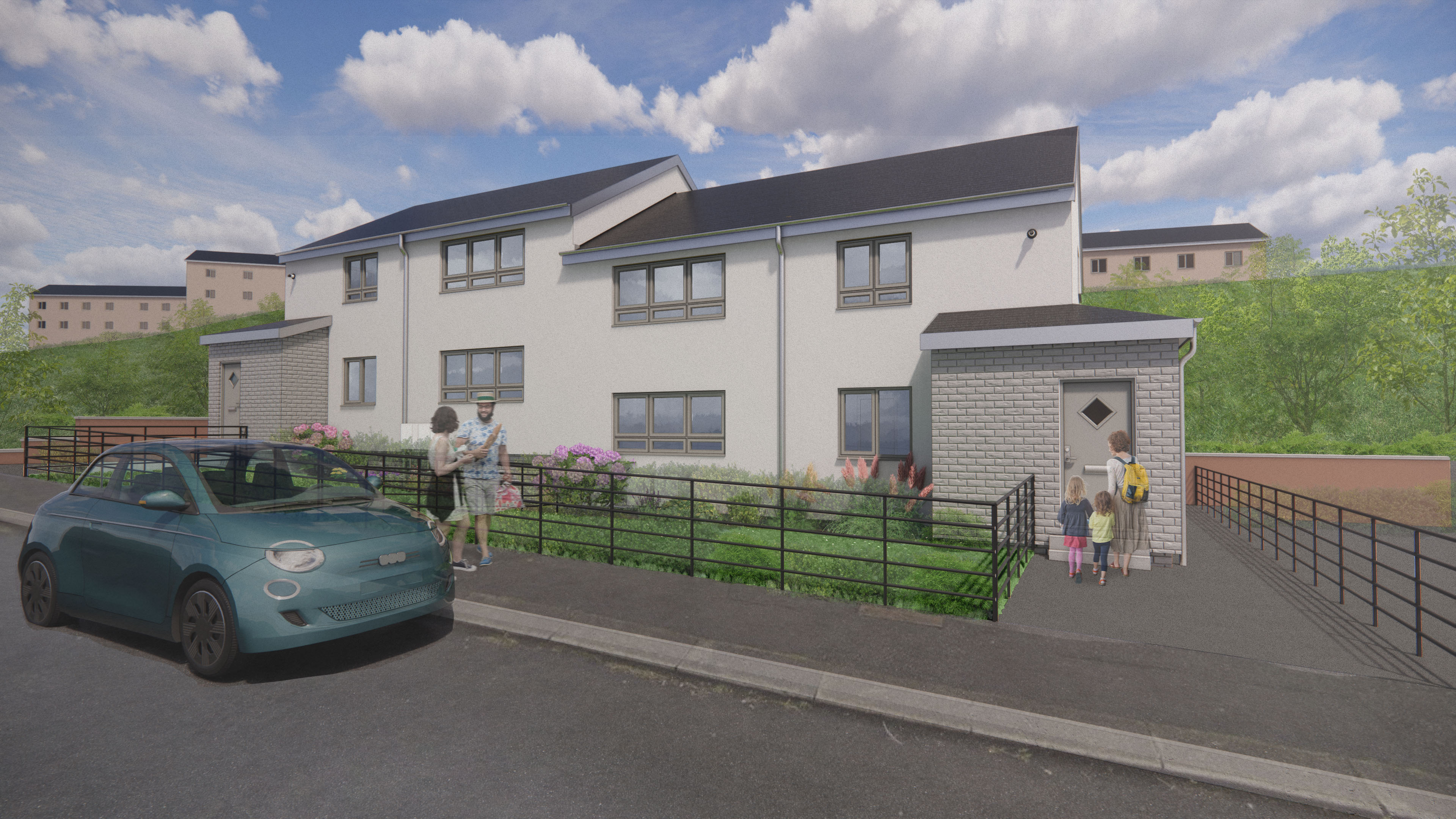
Duncan Smith, head of energy & sustainability at River Clyde Homes, details a pilot project being undertaken which aims to transition homes from fossil fuels while reducing fuel poverty.
The way we heat and power our homes is going to radically change towards becoming a net zero country in 2045, and it’s one of the biggest challenges the housing and social rented sector faces over the coming decade.
How we transition our homes from central heating systems that use fossil fuels, such as gas, to renewables, such as heat pumps and low-carbon heat networks, will require a huge amount of skills and expertise to be developed within the next few years to get it right – to make it work!
However, in addition to becoming net zero, Registered Social Landlords must also meet the Scottish Government’s legally binding targets of reducing fuel poverty by 2040 through the Fuel Poverty Bill. This requires 95% of our homes to be outside fuel poverty by that date.
So the question that we are trying to answer is how do we retrofit our homes to make them less energy-dependent and more energy-efficient so they can comply with the new Social Housing Net Zero Standard (SHNZS), which is currently out for consultation from the Scottish Government but likely to be the metric that we have to work towards to 2033. How do we do this in an affordable and sustainable way?
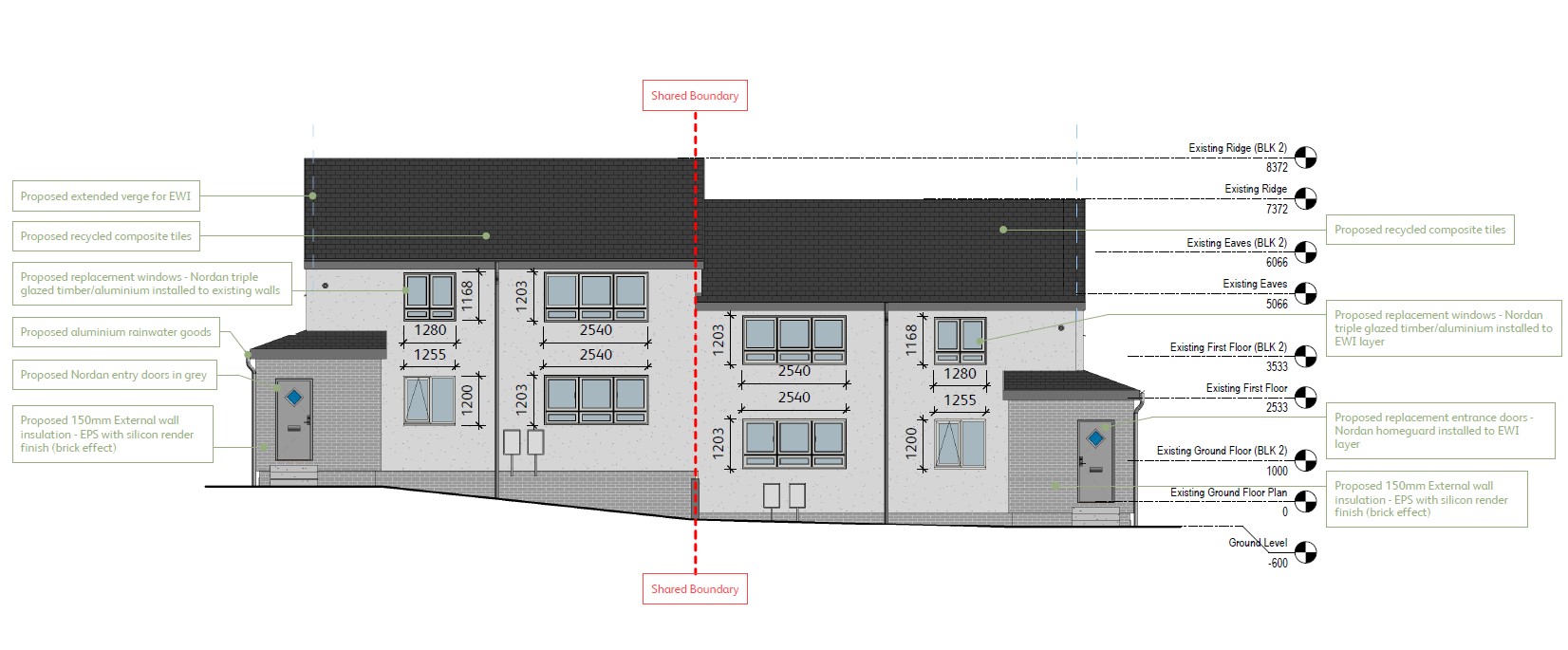
The main objective is how we, as a landlord, reduce the demand for space heating within a socially rented home and then provide affordable, clean heating through low-carbon heat networks or individual heat pumps.
And what lessons do we learn from this, and how do we implement them in our ongoing retrofit programme? It sounds easy; it’s anything but – there is no one size fits all, and the range and complexity of our historic housing stock make this incredibly challenging.
But these lessons are essential. They will allow the Association to transition to renewable or low-carbon heating, such as heat pumps, in a socially and environmentally sustainable way and towards the Scottish Government’s “Just Transition”.
Here at River Clyde Homes, we have a number of small-scale pilot projects that will assist with the development of what works the Association specifies within our retrofit contracts moving forward.
They include a range of zero-emission heating systems and fabric improvements. However, they focus on the following principles, which will develop a better understanding of how we deliver sustainable housing for those who most need it.
- Thermal comfort – how we provide warm, dry, comfortable homes for our customers
- Affordable heating – how we ensure that our customers are considered within a “Just Transition” through reducing energy demand within our homes and providing low carbon sustainable heating
- Healthy - how do we make sure our homes are well-ventilated and the internal air quality promotes a healthier environment
- Sustainable - how do we try and lower emissions both through operational as well as embodied carbon, and how might we stimulate local “sustainable” supply chains for environmentally friendly products
- Resilient – how we ensure that our homes are adaptable to future needs and requirements of both the occupants’ and the changing climate to which our buildings are exposed.
- Value for money - in that what we do now doesn’t constrain us from investing in the future
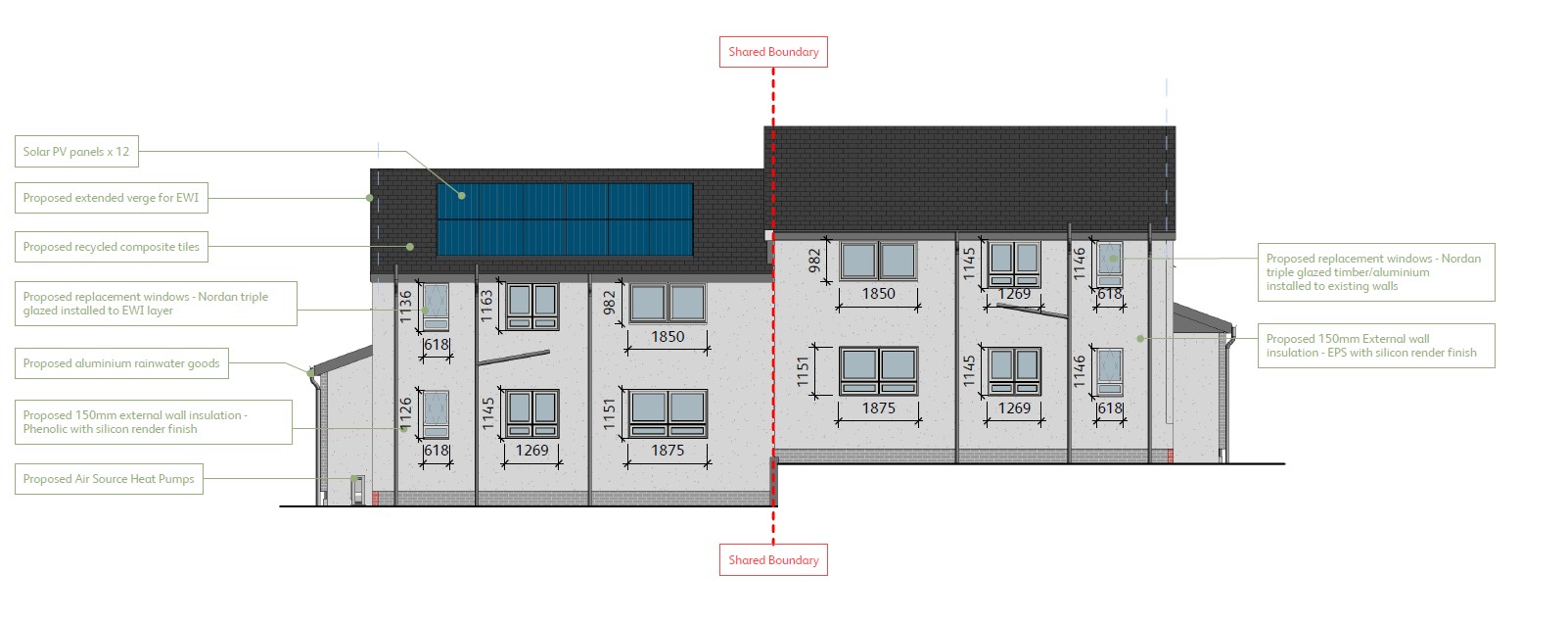
Huntly Drive - Deep retrofit & low carbon heating project
The four flats in Greenock are modest 50 sq metre 1950s cavity construction flats or cottage style four in a block – of which there are tens of thousands across Scotland.
The main objective is how we, as a landlord, reduce the demand for space heating within an average socially rented home through a blend of fabric improvements and heat pumps.
An important point is that the low-carbon electricity we all need as part of our net zero targets is currently around 29 pence a KWh. So, a good Coefficient of Performance (CoP) in social housing is critical if we’re using a heat pump.
The project will teach us how to practically over-clad cavity walls with external insulation and position the windows to mitigate thermal bridging, reducing heat loss and improving internal comfort levels. We’ll also focus on minimising the air changes with a range of air-tightness products.
We’ll determine which measures we can apply in tenanted homes – which might be a lighter retrofit within occupied homes and where we can undertake a deeper retrofit when the house doesn’t have an occupant or is void, as we say in the industry.
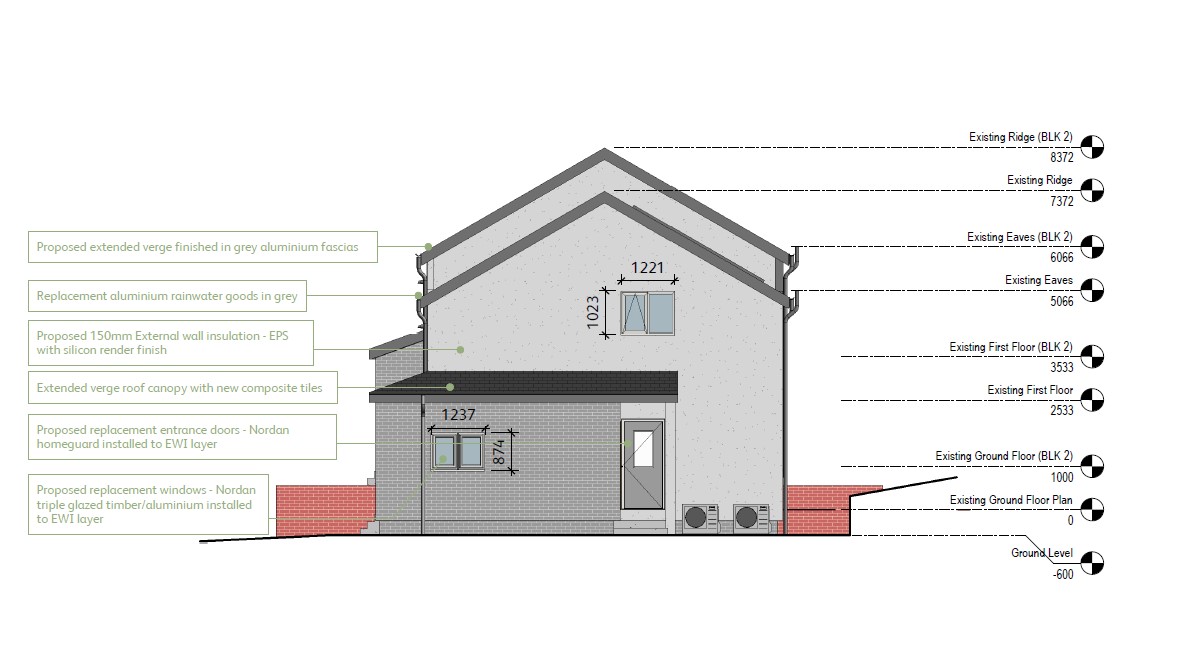
It will also allow us to identify what measures we prioritise now - as a must - and what we do in the future. So, how do we phase and implement retrofit within social housing in an affordable and viable way for the Association and our customers over the coming two decades?
Most importantly, how do we design and specify heat pumps to maximise their output and benefit our customers? This is important as a heat pump is a much more complicated piece of technology and much less forgiving than a gas boiler.
The Huntly project will inform the team how we ensure heat pumps and low-temperature heating systems are designed, installed and commissioned to maximise the CoP and mitigate fuel poverty for our customers.
We’ll aim to assess and understand both operational and embodied carbon within retrofit and how we try to limit the number of products with a high carbon footprint. We hope to use local, regional and national products and supply chains along the way.
We’ll favour more natural and environmentally friendly materials where possible, and an example of this is hemp-based insulation produced in Jedburgh, which we hope to use in the loft and underfloor.
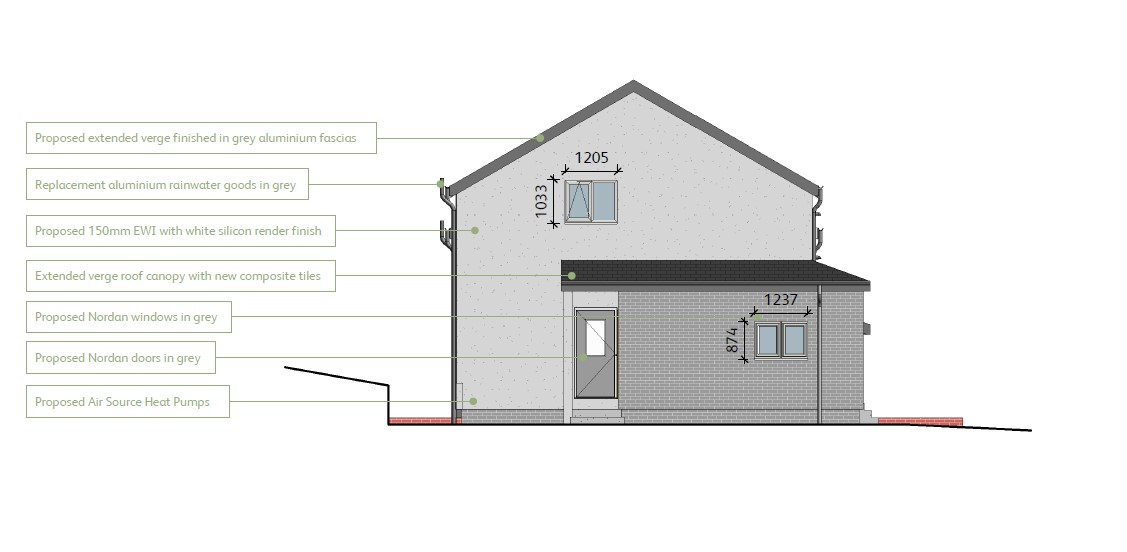
But we also need to be forward-thinking. How can we future-proof our homes – both in terms of asset management, maintenance, and value for money – and also from our changing climate?
However, we’ll also understand what measures we can put in place now to deal with possible overheating and increased rainfall in the future. To that end, we’ve looked at drainage, overshading and deep-flow aluminium rainwater gutters, which are all really important in this “future-proofing” context.
Often overlooked in retrofit, we need to ensure that there is good air quality for those living in our homes – especially if we are making them super insulated and more airtight. So Huntly will look at several ventilation systems and how effective they are through their continual measurement using IoT environmental sensors.
Also, from a tenant perspective, what practical measures can we put in place inside the home that make it easier for the tenant to stay there throughout their time living as an Association tenant?
These things are often overlooked within retrofit, which is understandably focused on energy efficiency and space heating demand, but the placement of electrical sockets at waist height – within a work programme now might - might make life easier for a tenant living there within ten years and be a small cost now compared to the future expense of rewiring a home.
So, the project is small in its physical size but really big in terms of the scope and what it will allow River Clyde Homes to understand what works best for our future projects and how we achieve value for money within our available budgets over the coming decade.





















